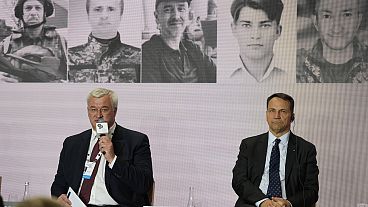Europe's 5G rollout has shown varied progress but certain countries are excelling in providing better coverage. Here's the picture so far.
The rollout and expansion of 5G networks across Europe have been advancing significantly in recent times.
Several operators have announced new milestones in their 5G coverage. However, some countries have lagged significantly behind the EU average in different aspects such as coverage, bandwidth, and speed.
First of all, what do we mean by 5G? The fifth-generation wireless technology is the new standard for mobile phone networks, designed to give faster connections with greater reliability.
Which countries have the strongest mobile networks, highest bandwidths, and fastest speeds in Europe?
Comparing bandwidth
Comparing the rollout of 5G across Europe is complex and cannot be determined by a single indicator due to various technical issues and definitions. Therefore, it is essential to examine different aspects.
The first aspect is pioneer band assignments. At the EU level, three 5G pioneer bands have been identified:
700 MHz (low-band)
3.6 GHz (mid-band)
26 GHz (high-band)
These bands roughly fit into the three categories of 5G frequencies often used by spectrum policymakers: low-band, mid-band, and high-band.
The percentages displayed in the table below indicate how much spectrum has been assigned to operators.
According to the 5G Observatory Biannual Report of June 2024, the 3.6 GHz band has been the most widely assigned among EU countries.
All EU members, except the Netherlands, have allocated at least 50 per cent of the targeted spectrum in this band, meaning at least 200 MHz out of 400 MHz.
12 countries assigned the high-band in the EU
The only remaining outlier, the Netherlands, recently held an auction after the report was published. As a result, this band has now been assigned in all EU Member States.
The second most assigned band is the 700 MHz band. Except for Malta and Poland, all 25 other EU countries have allocated at least 50 per cent of the targeted spectrum.
The least assigned band is the 26 GHz band, a high-frequency band. This band has been majority-assigned in only 12 EU countries.
Best and worst 5G performance
Germany and Croatia stand out as the best-performing countries, having already assigned 100 per cent of the spectrum in all three bands.
Other countries that have made significant progress, nearly reaching 100 per cent in all three bands, include Austria, Denmark, Finland, Greece, and Spain.
Conversely, Poland and Malta are the worst-performing countries, having assigned only one band.
When examining the percentage of harmonized spectrum assigned by 2023, it exceeds 97 per cent in 10 EU countries.
In contrast, this rate is below 70 per cent in 15 countries, with five of them assigning less than 50 per cent of the targeted spectrum.
4 countries have reached full coverage
According to data collected by Omdia/Point Topic for the European Commission's DESI, four EU countries - Denmark, the Netherlands, Malta, and Cyprus - achieved 100 per cent 5G coverage of households.
The EU average was 89.3 per cent in 2023. Nearly half of the EU countries reported that over 96 per cent of households have 5G coverage.
On the other hand, Romania, Belgium, and Latvia had the worst performance in this indicator, with less than 55 per cent coverage of households.
Regarding mid-band 5G coverage, specifically the 3.4–3.8 GHz range, the EU average was 50.6 per cent in 2023. Finland, Italy, and Denmark led with over 85 per cent coverage.
More than half of the EU countries reported less than 50 per cent coverage of households in this mid-band, including Germany. Belgium, Poland, and the Netherlands had the worst performance in this indicator.
"There could be various reasons for coverage disparities among different countries," said Richard Haas, a policy analyst at Policy Tracker, one of the three companies contributing to the 5G Observatory report.
"In Belgium, strict local EMF regulations have historically slowed the rollout. For example, 5G was only introduced in Brussels in July 2023 after the city relaxed these regulations. Conversely, Sweden has significantly improved its 5G coverage recently," he added.
How does download and upload speed performance compare?
Download and upload speed performance are among the most crucial indicators for users evaluating mobile network quality.
According to the Speedtest report from June 2024, Norway leads European countries with a median download speed of 145.2 Mbps, closely followed by Denmark at 144.9 Mbps. The Netherlands also performs strongly, with a median download speed of 121.0 Mbps.
Conversely, Ireland lags significantly with a median download speed of 41.1 Mbps, just below Turkey at 42.0 Mbps and Spain at 50.7 Mbps.
As to the upload speed, North Macedonia leads in upload speeds across Europe with a median of 25.5 Mbps, followed by Czechia at 20.9 Mbps and Norway at 20.7 Mbps.
These countries demonstrate exceptional network performance, ensuring that users experience high-speed connectivity.
On the contrary, Luxembourg and Malta lag behind, with median upload speeds of 6.0 Mbps and 7.7 Mbps, respectively. The UK also falls short with an upload speed of 7.7 Mbps.
Regarding the best indicator to compare 5G performance, "This depends on who you ask. Ericsson likes to point to mid-band coverage (1–6 GHz) as a good indicator of 'good quality' 5G," Haas said.
"However, when looking at the extent of wide area coverage, most of this will be using the lower band (sub 1 GHz) due to its favorable propagation characteristics," he added.
All these figures underscore the stark contrasts in mobile network speeds across Europe, reflecting varying levels of investment and infrastructure development in 5G technology among different countries.















